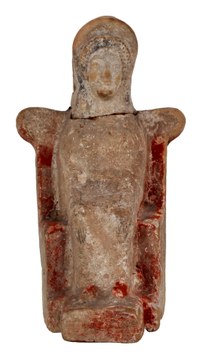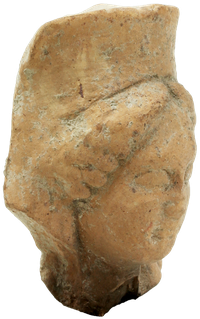T I-4 Enthroned Woman
|
|
Enthroned Woman, Inv. T I-4 Front from the mould, back not finished, smooth, rounded at the head. Hollow at the bottom (kilning hole). Finely muddy brownish (7.5 YR 7/5) clay. White engobe. Abundant traces of red paint, especially on the throne and feet. Dark grey-blue in the hair and on the shoulders. Forearms and hands outlined in dark grey; fingers dashed. Provenance: Acquired by Bruno Sauer with special funds for the university anniversary in 1907. State of preservation: Head with neck broken off at an angle and attached. Injuries to the veil and the side rest on the right. Missing part at the lower left edge of the chair. Dimensions: H: 14,4 cm. W: 8,1 cm; D: 6,5 cm. References: D. Graen – M. Recke, Herakles & Co (Gießen 2010) 45 f. fig. 11; M. Recke, Neues aus der Antikensammlung - Jahresbericht 2010-2011, 5 b; E. Neuffer, Griechische Terrakotten, Heimat im Bild no. 17, 1930, 66, fig. 1; W. Zschietzschmann, Gießener Antiken, Hessische Heimat 15, 18. 07. 1962, 57 fig. 1. |
Description: The female figure is enthroned on a wing chair with a straight backrest, her feet on a rectangular stool; her hands with the carefully indicated slender fingers rest on her knees. Over a tight-fitting chiton, the woman wears a cloak that also encloses her head and stephane and falls symmetrically over her shoulders. A thick bead of four rows of curls forms an arch over the forehead and reaches down to the cheeks. The elongated face, tapering towards the prominent broad chin, is dominated by the large nose. Wide-set eyes bulge under high orbitals.
Commentary: Women adorned with diadems at different heights, enthroned on wing chairs, are particularly common in Attica. The prototype was probably made in Athens. A significant number of them were found on the Acropolis. Specimens equipped with a gorgoneion or helmet unmistakably refer to Athena, the patron goddess of the city[1].
The Giessen statuette differs from the so-called Ear-Muffs Group[2], dated between 510 and 490 BC, which is characterised by a high, protruding diadem and a broad, tautly tapering face[3], by its narrow outline, elongated head shape and delicate diadem. Straight cheeks and a broad chin give the lower face a certain gravity. The curvature of the eyeballs is comparatively slight. The lateral edges of the Ear-Muffs are strictly vertical, whereas in the "Ear-Muffs Group" they strive slightly downwards towards each other[4].
The narrower comparison group for the Giessen statuette is quite small. Specimens in Brauron and Houston[5], Amsterdam, Paris and Hanover belong to it[6], as well as a striding robed figure also preserved in Amsterdam[7].
The heavy lower face of T I-4 already indicates the severe style. The brownish colour of the clay gives no definite indication of the landscape in which it was made; Attica and Boeotia are equally likely.
Determination: 480 BC; Attic type.
[1] A. Köster, Die griechischen Terrakotten (Berlin 1926) 52 pl. 26; R. Nicholls, Two Groups of attic terracottas, in: D. Kurtz – M. Sparkes, The Eye of Greece. Festschr. M. Robinson (Cambridge 1982) 99 fig. 24 b. ibid. fig. 24 g; E. Rohde, Griechische Terrakotten (Berlin - Tübingen1968) 39, pl. 12; P. Schollmeyer – D. Grassinger, Athena – Lehrerin und Schutzherrin prächtiger Werke, in: Die Rückkehr der Götter. Berlins verborgener Olymp (Berlin 2008) 213 fig. 212; V. M. Strocka, Mütterliche Athena, in: M. Kiderlen – V. M. Strocka (eds.), Die Götter beschenken (München 2005) 106 fig. 107. With helmet: Acropolis museum. guide (Athens 2016) 166 f. fig. 194; M. S. Brouskari, Musée de l'Acrople (Athènes 1974) 36 f. fig. 41.
[2] Nicholls ibid. 93-105 figs. 23 a – 25 d.
[3] Vierneisel-Schlörb ibid. 27 no. 70 pl. 17, 1.
[4] Nicholls ibid. 93-106 figs. 23 d. and 25 e.
[5] V. Mitsopoulos Leon, Brauron. Die Tonstatuetten aus dem Heiligtum der Artemis Brauronia (Athen 2009) 164 no. 394 fig. 1 pl. 55; B. Sismondo Ridgway, Images of Athena on the Acropolis, in: J. Neils (eds.), Goddess and Polis (Princeton 1992) 122. 148 fig. 6.
[6] P. Leyenaar-Plaisier, Griekse Terracotta's (Haag 1986) 29 fig. 11; S. Mollard-Besques, Cat. raisonné des figurines et reliefs en terre-cuite grecs, étrusques et romains (Paris 1954) 14 B 82 pl. 10, supposedly from Tanagra; U. Liepmann, Griechische Terrakotten, Bronzen, Skulpturen. Kestner-Museum (Hannover 1975) 46 T 19
[7] Nicholls ibid. 108 fig. 29 d.




